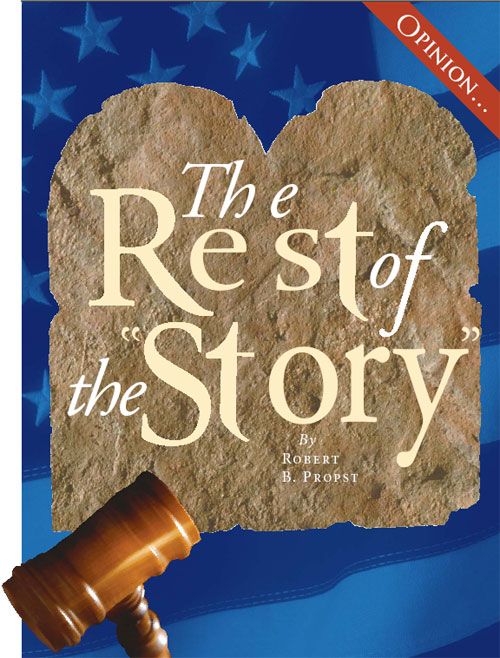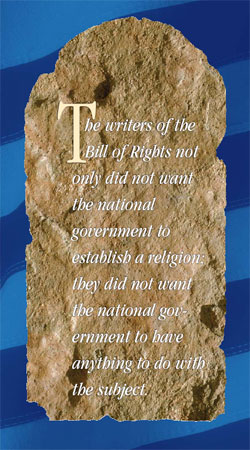The Rest of the "Story"
Robert B. Propst March/April 2005
Getting your Trinity Audio player ready...

I start by making it clear that I do not countenance any person's failing to comply with a lawful court order. Second, I do not believe that either Judge Myron Thompson or the Eleventh Circuit Court of Appeals panel had any choice but to render the decisions that they did in view of the controlling precedents of the Supreme Court of the United States. I also find no fault in the decision of the Alabama Court of the Judiciary to remove Alabama chief justice Roy Moore from office. While I agree with some of his statements on how the law has developed, I feel that his methods have been a distraction from the real issue.
I do not know whether Judge Moore is a demagogue or merely a West Point graduate who has accepted the ACLU's challenge. I do know that the ACLU helped create his celebrity and his political platform by its nit-picking. It chose to have relatively disinterested parties make an issue of newly elected circuit judge Moore's placement at his bench of a small Ten Commandments plaque that he had personally crafted. The rest, as they say, is history.
I am continually intrigued by the fact that so little attention is paid to how the so-called law of separation of church and state has been developed. As is often the case, court decisions based upon result orientation, not the language of the Constitution, are accepted without further examination of the methods by which the decisions are reached. The September/October 1998 issue of Liberty published my article called "Ku Klux Icon," in which I stated that much of the law in this area was fashioned by Supreme Court justice Hugo Black, for whom my federal courthouse in Birmingham, Alabama, is named. I suggested that his Ku Klux Klan background was an example of the political expedience that prevailed in his career, and that his membership in that organization likely influenced his opinion in Everson v. Board of Education, which redefined (or rewrote) the First Amendment term "establishment."
Black purported to rely on the Fourteenth Amendment's "incorporation" of the First Amendment's establishment clause in writing his opinion in Everson. His Everson opinion reflected the typical historical inaccuracies and selectivity that have governed in this area. In the earlier article I mentioned the law review articles of two Stanford University law professors, one a Pulitzer Prize winner who, in 1949 when some objectivity still existed, charged Black with distorting history in order to read into the Constitution provisions he thought ought to be there. I also noted that the present interpretation of the establishment clause began in the 1930s as part of the "secularization hypothesis" of the intellectual elite.

In his Book of Legal Lists (1997), professor Bernard Schwartz demonstrated that he generally had little regard for those who have questioned the recent establishment clause law. He condemned Judge Hand's Jaffree v. Board of School Commissioners opinion as being the second-worst non-Supreme Court opinion of all time. He elevated Justice Black to the eighth greatest Supreme Court justice of all time. On the other hand, Schwartz was compelled by history to rank Justice Story as the fourth greatest Supreme Court justice of all time. Not only did Schwartz rank Story highly as a Supreme Court justice; he ranked Story's Commentaries on the Constitution of the United States (1833) as the third -best law book of all time. We seldom see, however, a discussion of this great justice's views of the establishment clause.
One of the key points that Story makes is that the governmental fostering of religion had never been considered to be against the "principles" of "republican liberty." This recognition flies in the face of the recent Supreme Court holdings that the Fourteenth Amendment due process "liberty" clause creates a high and impregnable wall of separation between church and state. This is significant because Black and others have relied on the liberty clause to justify their revised establishment law.
A few quotes from Justice Story's great Commentaries will illustrate the true picture:
"Indeed, the right of society or government to interfere in matters of religion will hardly be contested by any persons, who believe that piety, religion, and morality are intimately connected with the well being of the state, and indispensable to the administration of civil justice. The promulgation of the great doctrines of religion, the being, and attributes, and providence of one Almighty God; the responsibility to him for all our actions, founded upon moral freedom and accountability; a further state of rewards and punishments; the cultivation of all the personal, social, and benevolent virtues;—these never can be a matter of indifference in any well ordered community. It is, indeed, difficult to conceive, how any civilized society can well exist without them" (